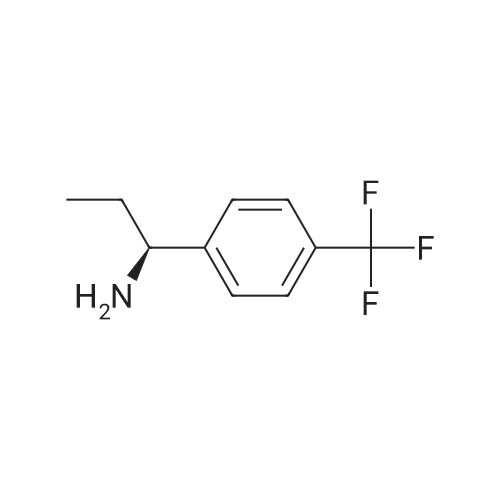Cat.NO.:A1258129 Purity:95%
Product Details of [ 1003887-67-9 ]
| CAS No. : | 1003887-67-9 |
| Formula : |
C10H12F3N |
| M.W : |
203.20
|
| SMILES Code : | N[C@@H](CC)C1=CC=C(C(F)(F)F)C=C1 |
| MDL No. : | MFCD08439002 |
| InChI Key : | YOETTZCHIABKPH-VIFPVBQESA-N |
| Pubchem ID : | 51440024 |
Safety of [ 1003887-67-9 ]
| GHS Pictogram: |   |
| Signal Word: | Danger |
| Hazard Statements: | H302-H315-H318-H335 |
| Precautionary Statements: | P261-P264-P270-P271-P280-P302+P352-P304+P340-P305+P351+P338-P310-P330-P332+P313-P362-P403+P233-P405-P501 |
| Class: | 8 |
| UN#: | 2735 |
| Packing Group: | Ⅲ |
Computational Chemistry of [ 1003887-67-9 ] Show Less
Physicochemical Properties
| Num. heavy atoms | 14 |
| Num. arom. heavy atoms | 6 |
| Fraction Csp3 | 0.4 |
| Num. rotatable bonds | 3 |
| Num. H-bond acceptors | 4.0 |
| Num. H-bond donors | 1.0 |
| Molar Refractivity | 48.73 |
| TPSA ?
Topological Polar Surface Area: Calculated from |
26.02 Ų |
Lipophilicity
| Log Po/w (iLOGP)?
iLOGP: in-house physics-based method implemented from |
2.36 |
| Log Po/w (XLOGP3)?
XLOGP3: Atomistic and knowledge-based method calculated by |
2.59 |
| Log Po/w (WLOGP)?
WLOGP: Atomistic method implemented from |
3.94 |
| Log Po/w (MLOGP)?
MLOGP: Topological method implemented from |
3.19 |
| Log Po/w (SILICOS-IT)?
SILICOS-IT: Hybrid fragmental/topological method calculated by |
2.98 |
| Consensus Log Po/w?
Consensus Log Po/w: Average of all five predictions |
3.01 |
Water Solubility
| Log S (ESOL):?
ESOL: Topological method implemented from |
-2.85 |
| Solubility | 0.287 mg/ml ; 0.00141 mol/l |
| Class?
Solubility class: Log S scale |
Soluble |
| Log S (Ali)?
Ali: Topological method implemented from |
-2.79 |
| Solubility | 0.333 mg/ml ; 0.00164 mol/l |
| Class?
Solubility class: Log S scale |
Soluble |
| Log S (SILICOS-IT)?
SILICOS-IT: Fragmental method calculated by |
-3.77 |
| Solubility | 0.0344 mg/ml ; 0.000169 mol/l |
| Class?
Solubility class: Log S scale |
Soluble |
Pharmacokinetics
| GI absorption?
Gatrointestinal absorption: according to the white of the BOILED-Egg |
High |
| BBB permeant?
BBB permeation: according to the yolk of the BOILED-Egg |
Yes |
| P-gp substrate?
P-glycoprotein substrate: SVM model built on 1033 molecules (training set) |
No |
| CYP1A2 inhibitor?
Cytochrome P450 1A2 inhibitor: SVM model built on 9145 molecules (training set) |
No |
| CYP2C19 inhibitor?
Cytochrome P450 2C19 inhibitor: SVM model built on 9272 molecules (training set) |
No |
| CYP2C9 inhibitor?
Cytochrome P450 2C9 inhibitor: SVM model built on 5940 molecules (training set) |
No |
| CYP2D6 inhibitor?
Cytochrome P450 2D6 inhibitor: SVM model built on 3664 molecules (training set) |
Yes |
| CYP3A4 inhibitor?
Cytochrome P450 3A4 inhibitor: SVM model built on 7518 molecules (training set) |
No |
| Log Kp (skin permeation)?
Skin permeation: QSPR model implemented from |
-5.7 cm/s |
Druglikeness
| Lipinski?
Lipinski (Pfizer) filter: implemented from |
0.0 |
| Ghose?
Ghose filter: implemented from |
None |
| Veber?
Veber (GSK) filter: implemented from |
0.0 |
| Egan?
Egan (Pharmacia) filter: implemented from |
0.0 |
| Muegge?
Muegge (Bayer) filter: implemented from |
1.0 |
| Bioavailability Score?
Abbott Bioavailability Score: Probability of F > 10% in rat |
0.55 |
Medicinal Chemistry
| PAINS?
Pan Assay Interference Structures: implemented from |
0.0 alert |
| Brenk?
Structural Alert: implemented from |
0.0 alert: heavy_metal |
| Leadlikeness?
Leadlikeness: implemented from |
No; 1 violation:MW<1.0 |
| Synthetic accessibility?
Synthetic accessibility score: from 1 (very easy) to 10 (very difficult) |
1.68 |
Application In Synthesis of [ 1003887-67-9 ]
* All experimental methods are cited from the reference, please refer to the original source for details. We do not guarantee the accuracy of the content in the reference.
- Downstream synthetic route of [ 1003887-67-9 ]
[ 1003887-67-9 ] Synthesis Path-Downstream 1~5
| Yield | Reaction Conditions | Operation in experiment |
|---|---|---|
| 23% | With periodic acid; methylamine; In methanol; water; at 0 – 20℃; | 40% MeNH2 in water (11.3 mL, 30 eq) was added to a solution of (S)-2-(S)-l-[4-(trifiuoromethyl)phenyl]propylamino-2- phenylethanol (1.43 g, 4.42 mmol) in MeOH (17 mL). The solution was cooled to O0C and a solution OfH5IOe (6.0 g, 6 eq) in water (17 mL) was added dropwise. A white precipitate formed. The resulting reaction mixture was stirred at room temperature overnight. Et2O (85 mL) and water (57 mL) were added. The organic layer was separated, and the aqueous layer was extracted with Et2O (85 mL). The combined organic layers were concentrated to 11 mL and cooled to O0C. IN HCl (17 mL) was added dropwise followed by stirring at room temperature for 1 h. The solution was cooled to O0C, basified with solid NaOH pellets to pH 12 and extracted with Et2O (2 X 85 mL). The combined organic layers were dried over Na2SO4 and concentrated. Purification with flash column chromatography eluting with 4% 7 N ammonia in MeOH/DCM provided the desired product as pale yellow oil (0.245 g, 23%). 1H NMR (300 MHz, d-CHCl3) δ 0.85 (t, 3H), 1.67 (m, 2H), 3.87 (t, IH), 7.41 (d, 2H), 7.56 (d, 2H). MS: calculated: 203.09, found (MH+): 203.9. |
| Yield | Reaction Conditions | Operation in experiment |
|---|---|---|
| In dichloromethane; at 20℃; for 3.0h; | Triphosgene (43.5 mg,0.15 mmol) in dichloromethane (1 mL) was added dropwise to (S)-l-(4-(trifiuoromethyl) <n=”39″/>phenyl)propylamine (89.4 mg, 0.44 mmol) in dichloromethane (1 niL). The mixture was stirred at room temperature for 3 h; a precipitate formed. This material was used directly to the next step. |










Reviews
There are no reviews yet.